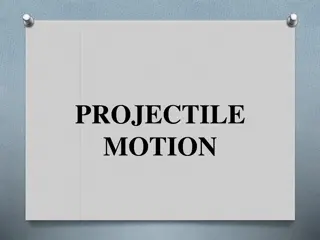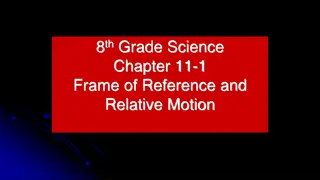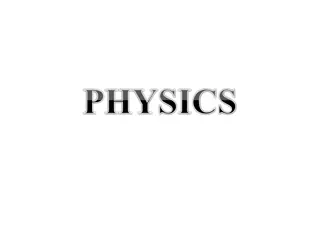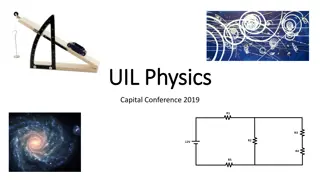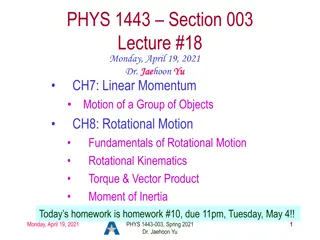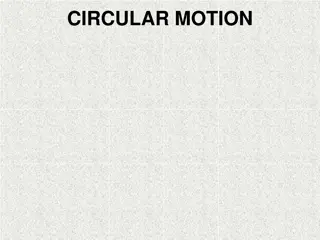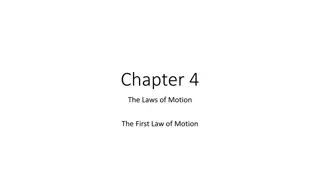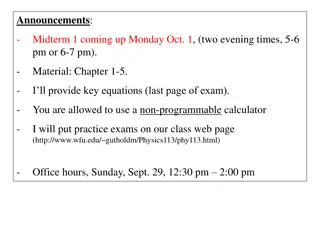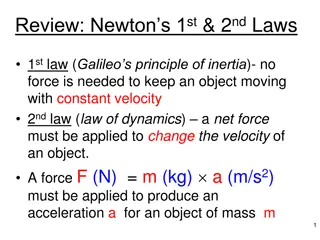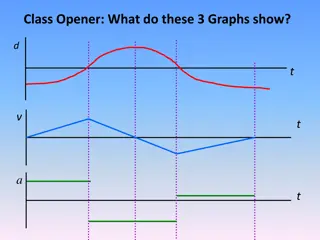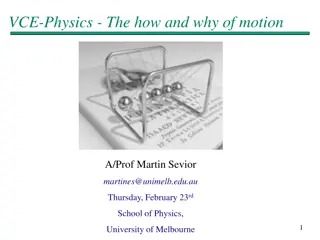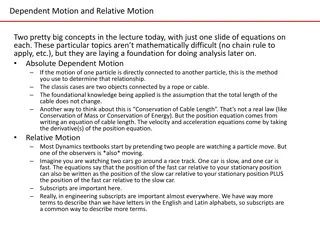Motion: Concepts and Definitions in Physics
Motion in physics is defined as the change in position of an object over time. It involves concepts like rest, motion, distance, displacement, rate of motion, and types of motion. Rest and motion are relative to a reference point, while distance and displacement differ in their scalar and vector nature. Rates of motion can be average or instantaneous, and motion can be uniform or non-uniform based on the object's movement pattern. This chapter explores these fundamental principles to help comprehend the dynamic nature of objects in motion.
Download Presentation

Please find below an Image/Link to download the presentation.
The content on the website is provided AS IS for your information and personal use only. It may not be sold, licensed, or shared on other websites without obtaining consent from the author.If you encounter any issues during the download, it is possible that the publisher has removed the file from their server.
You are allowed to download the files provided on this website for personal or commercial use, subject to the condition that they are used lawfully. All files are the property of their respective owners.
The content on the website is provided AS IS for your information and personal use only. It may not be sold, licensed, or shared on other websites without obtaining consent from the author.
E N D
Presentation Transcript
SAINIKSCHOOL GOPALGANJ CLASS IX CHAPTER MOTION BY Dr A K CHOUBEY (TGT)
CHAPTER 8 MOTION
Motion is defined as the change in position of body with time. To describe the position (location) of an object we need to specify a reference point called the origin. Let us assume that a school in a village is 2 km north of the railway station. We have specified the position of the school with respect to the railway station. In this example, the railway station is the reference point. We could have also chosen other reference points according to our convenience.
Concept of Rest and Motion A body is said to be in rest if its position does not vary with respect Rest to a given referral point as time passes. Motion: A body is said to be in motion if there is a continues change in its position with respect to a given referral as time passes. Concept of rest and motion is related to referral change in position so a single object can be at rest or motion same time with different referral points. If we consider a single object as referral point and consider it as rest, as a absolute point any object which is at rest with respect to that point is considered at rest and same case with motion. In general we consider Earth as absolute point considering it at rest, Although It is in motion with respect to Sun and other planets
Distance And Displacement The actual path covered during motion of The Change in position made during a body It is needed not to be the Shortest path between two points It is the Scalar quantity as It does not have any particular direction motion of a body is known as displacement It is the shortest path between initial and final position It is a vector quantity as it is always directed.
Concept of Rate of Motion: Rate is defined as ratio of change in two quantities Rate is of two types . Average Rate of quantity A with respect to B net change in A net change in B .lnstantaneous Rate is rate at an Instant that is for very short interval of time. .Speed, Velocity and Acceleration are examples of Rate. Speed=Distance/Time Average Speed =Total Distance Travelled/Total Time Taken
Uniform and non Uniform motion Uniform Motion- If a body travels equal distance in equal intervals of time then it is in uniform motion Non-uniform motion- If a body travels unequal distance in equal intervals of time then it is in uniform motion
Distance and Displacement Distance= the total path length covered by an object from the initial position to the final position . Displacement= The shortest distance between the initial and the final position.
Measuring the Rate of Motion- Different objects may take different amounts of time to cover a given distance. Some of them move fast and some move slowly. One of the ways of measuring the rate of motion of an object is to find out the distance travelled by the object in unit time. This quantity is referred to as speed. Speed=Distance/Time Average Speed =total distance travelled/Total time taken
Velocity The rate of motion is more meaningful if we specify if we specify its direction of motion with speed, which is termed as velocity. It is a vector quantity. Velocity=Dispalcement/Time Average velocity= Total Dispalcement/Total Time =v+u/2
ACCELERATION The quantity which specifies changes in velocity is acceleration. Acceleration :- It is the change in velocity of a body per unit time. ( or the rate of change of velocity.) Acceleration = Change in velocity/ Time If the velocity of a body changes from initial value u to final value v in time t, then acceleration a is a = v u/t .The SI unit of acceleration is ms - 2
Acceleration The rate of change of velocity is termed as acceleration. (During non-uniform motion) Acceleration =a=v-u/t Its SI unit is m/s2 Uniform acceleration-When the change in velocity is equal in equal intervals of time. Non-Uniform acceleration-When the change in velocity is unequal in equal intervals of time.
Distance time graphs For a body moving in uniform motion
Velocity Time Graphs For a body moving with uniform velocity
For a body moving with non-uniform acceleration
EQUATIONS OF MOTION V=u+at (velocity time relation) S=ut+1/2at2(position time relation) V2-u2=2as (position velocity relation)
Uniform circular motion :- If a body moves in a circular path with uniform speed, its motion is called uniform circular motion. Uniform circular motion is accelerated motion because in a circular motion a body continuously changes its direction. The circumference of a circle of radius r is given by 2 r.
Circular motion The motion of a body in a circular path is called a circular motion. For a uniform circular motion
Take a piece of thread and tie a small piece of stone at one of its ends. Move the stone to describe a circular path with constant speed by holding the thread at the other end. Now, let the stone go by releasing the thread. Repeat the activity for a few times by releasing the stone at different positions of the circular path, check whether the direction in which the stone moves remains the same or not. OBSERVATION- on being releasedthe stone moves along tangential to the circular path. This shows that the direction of motion changed at every point when the stone was moving along the circular path. Uniform circular motion is an accelerated motion Acitivity a straight line


